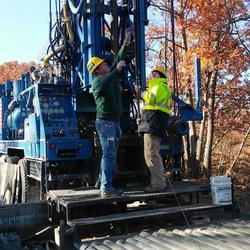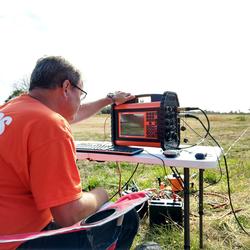Hydrogeologic Characterization
Hydrogeologic Characterization
Filter Total Items: 63
Geohydrology of the Valley‐fill Aquifer in the Lower Fall Creek Valley, Town of Dryden, Tompkins County, New York
PROBLEM The valley‐fill aquifer in the lower Fall Creek valley (designated as aquifer 4, fig. 1), within the Towns of Dryden and Groton, was mapped by Miller (2000) and identified as one of 17 unconsolidated aquifers in Tompkins County that need to be studied in more detail. The east end of the valley (near the Tompkins and Cortland County border) is on the backside of a large morainal plug, which
Geophysical Methods Capabilities
Geophysics Geophysics GEOPHYSICAL METHODS CAPABILITIES The New York Water Science Center (NY WSC) makes extensive use of geophysical methods in its hydrologic investigations and research in cooperation with local, State, and Federal partners. The NY WSC staff has many years of experience in collecting and interpreting surface and borehole geophysical data, and applying the results to provide a
DETAILED AQUIFER MAPPING OF THE SPRINGVILLE, N.Y. AREA Erie, Cattaraugus, and Wyoming Counties, New York
Introduction Public-water systems at Springville and Yorkshire/Delavan, N.Y. along Cattaraugus Creek draw from local groundwater resources and serve about 5,500 people (U.S. EPA SDWIS database). The remainder of the population obtains water from domestic wells, many of them completed in glacial aquifers. A Cattaraugus Creek tributary valley (Buttermilk Creek) to the south is the site of the West V
DETAILED AQUIFER MAPPING OF THE MALONE, N.Y. AREA (Adirondack foothills and St. Lawrence lowlands transect) Franklin County, New York
Introduction The Village of Malone, Franklin County, New York is located along the Salmon River where it exits the northern foothills of the Adirondack Mountains and flows northward across the St. Lawrence Lowlands until its confluence with the St. Lawrence River. The public water supply of the Village of Malone serves a population of 13,200 (U.S. EPA SDWIS database), which includes three correcti
Determination of Sources of Water to the Tully Valley Mudboils
Background and Problem Tully Valley is part of the Onondaga Trough, which extends from the Valley Heads Moraine in the south to Onondaga Lake in the north near Syracuse, New York (fig. 1). The Onondaga Trough is filled with a complex sequence of glacial and post-glacial sediments that overlie Devonian carbonate rock and shale and Silurian shale and salt (fig.2). Mudboils, volcano-like cones o
Groundwater Sustainability of the Long Island Aquifer System
Groundwater sustainability can be best defined as the development and use of groundwater in a manner that can be maintained for an indefinite time without causing unacceptable environmental or socioeconomic consequences. Informed management of the Long Island aquifer system can help ensure a regionally sustainable groundwater resource. The USGS and New York State Department of Environmental...
Hydrogeologic-Framework Mapping - Long Island, New York
Home Long Island is underlain by unconsolidated Holocene deposits, glacial deposits of Pleistocene age, and coastal-plain deposits of Late Cretaceous age. These sediments consist of gravel, sand, silt, and clay underlain by crystalline bedrock of early Paleozoic age (fig. 1). The bedrock is relatively impermeable, and forms the base of the groundwater-flow system on Long Island. The geologic and...
Saltwater-Interface Mapping - Long Island, New York
Home Saltwater intrusion is the most common type of water-quality degradation in coastal-plain aquifers. In coastal areas, the hydraulic head under predevelopment (nonpumping) conditions is higher on land than in the surrounding saltwater embayments; thus, fresh groundwater flows seaward (from areas of high potential to areas of lower potential) and meets saltwater at an equilibrium point...
Groundwater-Flow Modeling - Long Island, New York
Home Numerical models provide a means to synthesize existing hydrogeologic information into an internally consistent mathematical representation of a real system or process, and thus are useful tools for testing and improving conceptual models or hypotheses of groundwater-flow systems. The goal of this effort is to develop a regional model for the Long Island aquifer system to simulate changes in...
Groundwater Sustainability - Long Island, New York
Home Groundwater sustainability can best be defined as the development and use of groundwater in a manner that can be maintained for an indefinite time without causing unacceptable environmental or socioeconomic consequences. Informed management of the Long Island aquifer system can help ensure a regionally sustainable groundwater resource. This study will evaluate the sustainability of Long...
The Use of Solute-transport Methods to Estimate Time-varying Nitrogen Loading Rates to the Peconic Estuary Resulting from Wastewater and Fertilizer Inputs to Groundwater in Suffolk County, New York (Peconic Solute Transport)
Problem The Peconic Estuary of eastern Long Island, New York, is undergoing development as the region transitions from a rural area dependent on agriculture and tourism to a suburban one with a larger year-round population. The glacial and coastal-plain sediments underlying Long Island comprise a sole-source aquifer system that supplies the region’s communities with potable water. The area surrou
Detailed Aquifer Mapping of the Oneonta Area Otsego and Delaware Counties, New York
Introduction The City of Oneonta and surrounding area is the major population center in Otsego County, N.Y. and home to two colleges (SUNY Oneonta and Hartwick College). The public water supply draws on both surface-water and groundwater sources and serves 15,954 people in the City of Oneonta and parts of the surrounding Town of Oneonta (City of Oneonta, 2013). The remaining population uses domest












